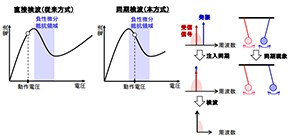
A trick for taming terahertz transmissions
Researchers at Osaka University invent a new receiver for terahertz-frequency radiation
An Osaka University research team has introduced a new terahertz detector that allows extremely rapid wireless data communication and highly sensitive radar by using a frequency range that has previously been very difficult to work with. Their approach combined sensitive electronics and a novel method for handling high frequencies to achieve the long-sought goal of using terahertz radiation for sending and receiving wireless data. The record 30 gigabit per second real-time error-free transmission they obtained may lead the way for next-generation (6G) cellular network technology.
Wireless data is in great demand. Not only do mobile phones need high speeds to stream videos on the go, but some people living in rural areas rely entirely on wireless for their home broadband connections. Terahertz radiation—electromagnetic waves with frequencies around 10 12 cycles per second—has long been tempting scientists and cell phone companies alike. The high frequency of terahertz radiation would allow more data to be transmitted per second, compared with the current standard of about 800 MHz. However, a practical terahertz receiver has remained elusive, for two main reasons. First, the electromagnetic oscillations are just too fast for conventional electronics to handle, and both the terahertz oscillator and detector have poor efficiency. Second, the thermal noise of the room-temperature detector obscures the received signals above.
Now, researchers at Osaka University have invented a novel receiver that not only overcomes these obstacles, it also set the record for the fastest error-free real-time transmission speed to date. They used a special electronic component called a resonant tunneling diode. In contrast with normal electronics - for which the current always increases at larger voltages - in a resonant tunneling diode, there is a specific “resonant” voltage that yields the peak current. Thus, there exists a region in which the current actually falls with increasing voltage. This nonlinear behavior allows the scientists to synchronize the rapid received terahertz signals with an internal electronic oscillator in the device, and then separate the data from the carrier wave. In the end, the sensitivity was enhanced by a factor of 10,000. “Among all electronic-based systems, ours achieved the highest error-free wireless transmission data rate,” says first author Yousuke Nishida.
Cell phone towers are not the only places you might find terahertz radiation in the future. “This technology can be put to work in a wide range of applications, in addition to next-generation 6G wireless communication. These include spectroscopic sensing, non-destructive inspection, and high-resolution radar,” adds corresponding author Masayuki Fujita.

Fig. 1 Method for coherent detection using a resonant tunneling diode (RTD). When the operating voltage of the RTD V o is set within the negative differential conductance (NDC) region, the RTD oscillates, which enhances the detected power compared with that from conventional direct detection. Here, injection-locking helps to synchronize the RTD oscillation with the received signal. As a result, coherent detection of terahertz waves can be achieved with a single RTD. (credit: Osaka University)

Fig. 2 The received power using coherent detection is larger than that of direct methods. The maximum enhancement factor is 10,000. (credit: Osaka University)

Fig. 3 Wireless communication experiments using an RTD transmitter and receiver with coherent detection. We achieved data transmission speeds of 30 Gbit/s with a bit-error rate less than 10 -11 . In this case, streaming video will not be interrupted during transmission, and is practically error-free. The inset is a picture of the fabricated RTD device. (credit: Osaka University)
The article, “Terahertz coherent receiver using a single resonant tunnelling diode,” was published in Scientific Reports at DOI: https://doi.org/10.1038/s41598-019-54627-8 .
Related links
